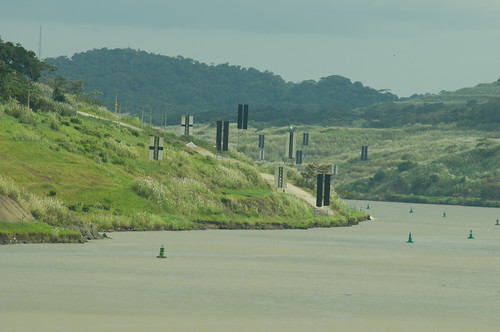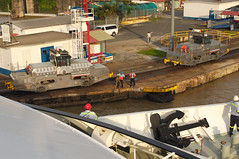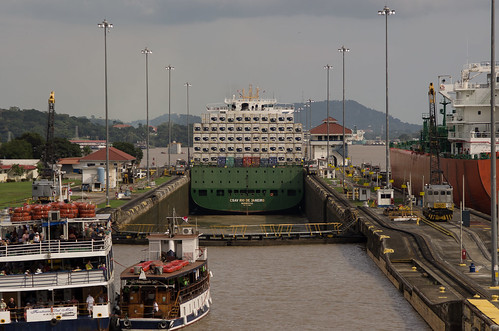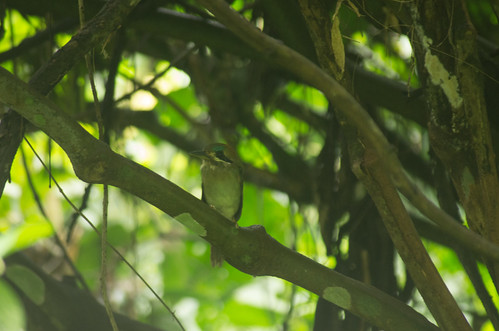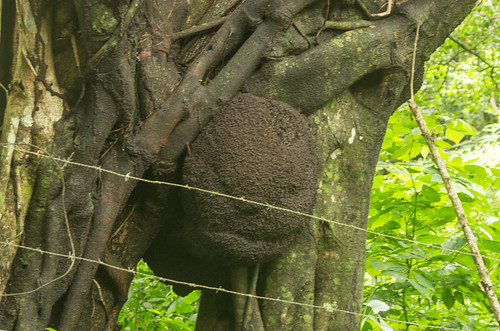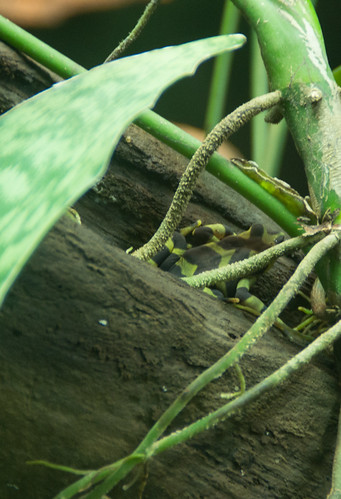Saturday, 23 November 2013
Day 8 - The Panama Canal
As the ship manoeuvred its way through the shipping in the bay, we passed a short, artificial channel. Chaundra had been reading David McCullough's The Path Between the Seas, a history of the several attempts to build the Panama Canal, and identified it as the remains of the French attempt to dig a canal through to sea level:
The history of the two French canal companies is (with hindsight) faintly comic, and Chaundra highly recommends the book.
The Panama Canal begins (or ends, depending on your direction of travel) on the Atlantic side with the Gatun Locks. Like all of the locks currently in operation the canal, it has two parallel flights. Chaundra and I both laughed at the enormous arrow-shaped signal indicating to oncoming vessels which of the flights they should enter, but admitted that it does make the intended direction clear.
On either side of the pier, you can see sets of Locher rack rails and small unpainted locomotives. These are the so-called "electric mules" that guide ships through the canal. Four mules, two on each side, attended our ship through each of the locks, but some of the larger cargo vessels, with much less clearance on either side appeared to be guided by up to eight.
Right in front of the pier, you can see two rowboats. These are, contrary to all reasonable expectation, used in every passage through the Panama Canal to carry the tethering cables for the electric mules from the shore to the ship and back again. Yes, rowboats.
Watching the antics of these antiquated craft entertained us to no end while we waited for the locks to fill and empty. In fact, it was astonishing to see how much of the process was still manual; both of us had expected that many of these tasks would have been automated to speed up the passage, given that before the Great Recession, the Canal was operating fairly close to maximum capacity.
There are three stages to the Gatun Locks, going up from the Atlantic to the artificial Lake Gatun, formed by damming the Chagres River just 10 kilometres upstream of its outlet. From there, the canal route crosses Lake Gatun (passing by Barro Colorado Island, one of the more renowned neotropical research centers) and across the continental divide through the excavated channel known as the Culebra (formerly Gaillard) Cut. The Culebra Cut is too narrow for the larger ships to pass, so even though the locks all have two flights, the canal operates in only one direction at a time. The way through the channel is marked by buoys and countless reflectors of different heights and shapes:
It seemed slightly inefficient to place so many markers together, especially since the turns of the channel made it difficult to distinguish which side the markers were on. Inefficiency seemed to be rule for the operation of the canal; many of the manual operations, such as passing the ropes leading the mule cables, were delayed by inattention to detail and unpreparedness. For example, at the Pedro Miguel locks, the rope that was passed was too tangled to actually reach the ship, and had to be pulled back and untangled.
At the Pedro Miguel locks we also had the opportunity to see a Panamax class ship - the largest that the canal can currently handle - pass through the locks before us.
We were told that Panamax ships have less than six inches of tolerance on either side; we did not measure for ourselves, but having seen the CSAV Rio de Janeiro pass through before us, could easily believe it. As a result, there are many bumpers and fenders at points of potential collision. Some of these (e.g., on the left) have clearly been more successful than others (e.g., on the right), and many of the ships do not always make it through unscathed (e.g., below).
The Pedro Miguel locks lower ships down to the level of Lake Miraflores, a small artificial lake that leads only to the the Miraflores locks, the last two stages of the Canal heading towards the Pacific. After passing through the Miraflores locks and the Port of Balboa, we passed under the Bridge of the Americas out into the Pacific Ocean, and so ended our transit of the Canal just as the sun was setting.
Thursday, 31 October 2013
Quick update
As you guys have probably noticed, we're rather behind on blogging and photo processing from our trip so far. This you should take as evidence that we're having an absolutely fantastic time - so many memories accumulated, along with around 6000 pictures taken between the two of us to help jog those memories along. All plans so far gone without a hitch and we've been taking daily notes to assist with the post writing once we're back - you may even get a few days from Stephen's perspective (!!) along with his pictures to boot.
But before then, we have two days left to enjoy to the fullest - two more days of sun and warmth to absorb - before we go back to London and our daily life. I'm not sure quite how we're going to manage this whole "daily life" thing as it seems so very far away, but I'm sure we'll figure it out. We'll have to plan some fun things to do to help ease the way a little bit right?
Looking forward to sharing it all with you, but for now, we have a dinner to find in town, another volcano to see, some (more) sun to absorb, and eventually a flight to catch.
Adios for now! Keep an eye out for more posts to come over the next few weeks.
Saturday, 19 October 2013
Day 7 - Three forts and a cruise ship (with a near miss)
Bright and early the next morning, we were downstairs and waiting in the brilliant sunshine for our historical tour of the other two key Spanish centres of trade - San Lorenzo & Portobello, which together are a UNESCO World Heritage Site*. This time it was Jeff (also from Barefoot Panama) who fetched us and much to our (pleasant) surprise we were joined by Maria from Seattle who had arrived into Panama the previous day.
Heading out of town, we first needed to cross the canal to get to Fort San Lorenzo, our first stop of the morning. We had been warned the day before by Kevin that crossing the canal can be pretty hit and miss and can involve long waits depending on what was happening shipping wise. I should have figured out from this description that we would be getting a quite close preview of the canal. What I wasn't expecting was to be on a rather rickety retractable "bridge" a mere handful of meters above the low water point of the first set of the Gatun Locks. Talk about amazing! And even better we got there right in the nick of time and drove straight through. . .with our mouths wide open.
Approaching the locks.
Coming out from under the arch, and there is a ship getting ready to transit through.
After a beautiful drive through Chagres National Park (which protects one of the important watersheds for the canal) and spotting quite a few interesting birds including a yellow headed caracara carrying off a rather large frog, we came to an unexpected (for us, Jeff clearly knew what was going on) military checkpoint that was the former entrance to the ex US base of Fort Sherman. The Panamanian military obviously still uses it as a training ground (they were doing some sort of amphibious manoeuvres while we passed through), but most of the buildings have been completely left to rot.
One of the old apartments for servicemen and their families.
It was a really striking contrast, but you could see the strategic importance with the shipping of the canal clearly visible in the background (see above).
A short drive through later, we arrived at Fort San Lorenzo. . .completely alone. It was quite surreal having the whole area to ourselves, but also a wonderful luxury and allowed us to explore almost completely unencumbered.
The entrance to the old fort
All the old canons, lined up. Unclear if these are originals for this location or if they were brought in from somewhere else.
Looking over at the area just beyond the canons, you can see the mouth of the Chagres River as it empties into the Caribbean Sea. In the glory days of the Spanish empire, this was one of the primary routes for bringing gold and silver from the Pacific to the Atlantic and so onward to Spain.
Looking back at the ruins from the Caribbean side.
Part of the pseudo still free standing guard rooms.
Another view from on top of the eastern fortification wall.
evidence we were, in fact, there, plus a peek at my new haircut for those of you who haven't seen it yet.
It was eerily beautiful and in the bright morning sun hard to imagine why more people didn't make the trip, but then again, I'm not sure how many visitors it could handle without additional damage being done. As you can see, there were virtually no restrictions to our access and no evidence of any sort of preservation activity. It's rather obvious why they've been designated as being "in danger".
After basking in the beauty and poking around to our hearts' content, it was back in the van and retracing our steps, back through Fort Sherman (where we got to chase after a military vehicle that didn't listen to their compatriots at the check point - kind of awesome), across the locks and over to the other side of Colon for yet another picturesque drive towards Portobello along the coast.
Arriving in Portobello we parked just outside the main square, and Jeff remarked how much more active the town was. Apparently it was a few days before one of the major local festivals - the pilgrimage and festival of the Christo Negro or Black Christ, so named for a very emotive statue of Christ carved from dark wood that resides in the local church. And indeed all through town the market stalls were beginning to set up and music was played from various corners.
the "unusually busy" town square
And turning around behind me, the old customs house where the gold and silver would be stored before being shipped to Spain once a year.
We walked through the big arches to the other side where we would also enter the main fortifications of the town, but first, we had to stop for a refreshment - a lady was serving fresh, green coconuts to all comers. I hadn't had coconuts like this since our trip to Singapore all those years ago.
hack off the top
add a straw - yum!
Suitably refreshed, it was time to explore the ruins of the old fort.
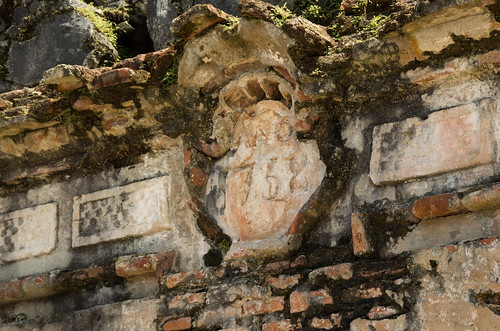 The lintel showing the date the town was founded - 1758
The lintel showing the date the town was founded - 1758
Shortly after passing through the main "gate", Jeff pulled us aside to show us the construction of the walls itself. Not only was it made of the usual brick and stone, but they had also included bits of coral. Talk about using whatever had come to hand! Below is one example, but we spotted others as we looked around.
Nothing more threatening these days than fishing boats.
What they think may have been the old powder store. Now more or less underwater.
Adventurer extraordinaire (also you can see other examples of the different kinds of coral used for building the walls)
Standing on the far side, looking back towards the customs house.
After poking about the ruined fort for a bit, we walked through the increasingly busy town to have a look at what remains of the old town.
The previous incarnation of the cathedral and hospital. Now it serves as a museum, which was closed the day we were there.
Then crossing over to visit the church that currently houses El Christo Negro, Iglesia de San Felipe.
It is quite a plain little church, but quite airy and with plenty of room
And the queues were already forming, even though it was still 3 days to the festival.
On the other side of the altar is a statue to our lady of mercy. You can just see that on the rosary between her hands are a pair of handcuffs. She's considered to particularly be concerned for convicts. While not paraded like the Black Christ, apparently families of those in jail or prison will come for miles to pray for their loved ones rehabilitation and safety.
We didn't stay long, while most people were praying, others were busy about the church getting it ready for the up coming festivities.
From there we walked through the rapidly expanding market back towards the customs house where we would go through the little museum and have a look at the gift shop which was also the old reception room and the only room refurbished to look as it would have in the 18th century.
Voila - that's Jeff off to the right. Realised later that I never g to a proper picture of him! Shame. Anyway, the part that was fenced off in the middle (and which I couldn't get a decent picture of due to the funky lighting) was a portion of the original floor under plexiglass.
After poking about it was time for lunch. Jeff took us down the road to a little placed called "Los Canones" just on the water's edge. A stunning setting for some really fantastic seafood. I had a selection of ceviches (sea bass & octopus) and a starter portion of their queen clam in cocunt sauce. S had some of their grilled sea bass on a bed of rice with fried plantains (patacones). Everything was cooked perfectly and very flavourful. Combined with a glass of the local beer it was pure bliss.
After lunch it was just back to Colon, more specifically to the port, for us to pick up our ship. Let's just say that the drive through town thoroughly convinced us that all the advice we'd read about Colon was absolutely true. A rougher more shabby looking town I'm not sure I had ever seen. Kind of a shame as there were quite a few buildings that despite their advanced stage of dilapidation had some lovely details.
We said good-bye to Jeff and Maria and headed off through what looked more like a shopping mall than a cruise port to find our ship. Unusually, there wasn't anyone to check our tickets or any other documentation and we weren't stopped until about 100 meters from the ship by a guy who spoke no English and who then reverted to gestures, ignoring our attempts at getting an explanation in Spanish. This is what is colloquially referred to as Not. Good.
He gestured for us to go off to the side and (through more gestures) we understood he wanted to take our luggage. This we patently refused. Cue a very frustrating exchange for some minutes including calling over one of his friends. I could see the ship from the area where we were and so figured if things got difficult (they almost did when he tried to take my handbag off my shoulder) we could make a dash for it or at least a lot of noise and surely one of the staff members would come over to help (I hoped). Right as things were getting quite heated (us not understanding what they wanted, them not explaining anything), another guy came out with what was obviously a drug dog. At that stage we finally understood what was going on and set the bags aside for a thorough sniffing. Disaster averted. On the way over the last hundred meters, Stephen finally got one of the guys to actually talk to us and he tried to say that it we would have complied right away had we known that all they wanted was to have the dog look at our bags. Instead of courtesy back instead we got chastised (in Spanish) for not telling them sooner we spoke Spanish!
From there it was a snip to check in (it seemed that we were the absolute last guests on board, even with two and a half hours still to go), and off to our suite to get cleaned up and unpacked before the muster drill and introductory talks. It was at this moment that Stephen and I started to think that perhaps our definition of "adventure travel" might be somewhat different than Silversea's. But, the suite was beautiful (with a very spacious verandah that would come in very handy indeed), the staff very kind, some of the other guests pretty interesting, and we were committed to having fun regardless.
(as always, these are only a selection of the pictures I took on the day. For the rest of the set, head over to my flickr page. You can also see Stephen's pictures too here.)
Friday, 18 October 2013
Day 6 - transfer to Colon via Lake Gamboa
Quite literally getting up with the birds, we had our last breakfast at Canopy Lodge and spent our last remaining early morning watching the feeders and enjoying the sunrising over the mountains.
Light coming through the valley
A toucanete!
A rufus tailed hummingbird - we watched this guy bounce around in the bush (related to a lantana) for probably a good twenty minutes. Love hummingbirds, even if getting photos of them is super tricksy.
An absolutely stunning location and one that although we knew there was plenty more adventure to come, we were a little reluctant to leave.
But, leave we eventually must and when Kevin from Barefoot Panama came down the path to meet us, we knew it was going to be interesting. An American who has made Panama his home, he had a lot of insight to share as we drove back down towards the coast and then across over to Soberenia National Park and Gamboa Lake. He was also shared with us an enormous amount of knowledge about the area - so if my narrative sounds even remotely informed, it's all due to him!
Soberenia is a huge national park spanning almost the entirety of the old American controlled Canal Zone and in the middle is Gamboa Lake created as part of the canal. However, of course, it flooded much more than was needed and all the old mountain tops became islands, the most famous of which is Barro Colorado Island where the Smithsonian has one of their most important research sites. This was not our destination for today (next time), instead we were headed for another little island and a community of the Wounan tribe. They had originally come from the Darien region at the turn of the century when Gamboa Lake was first flooded for the better access that the new location would provide while still maintaining their traditions.
And it is a rather lovely location no? Plenty of wildlife around too.

A flycatcher in some plants in the middle of the lake.
The village
As this was a normal working village, most of the villagers were off at work and so there were only a few women and young children around to greet us. They seemed to know Kevin quite well and were full of smiles and kind words for him. Kevin gave us a summary of their history and way of life, and took us on a walk through the forest near the village showing us the various plants they put to use and what they were for (medicines or dyes or other handicrafts). In the process we saw a goodly amount of wildlife including some leaf frogs (! so hard to spot in the wild, each one is such a treasure), an enormous leaf cutter ant colony and of course plenty of birds.
Kevin showing us the flaking bark of the "sunburned tourist tree" which some tribes use also for body paint and as a natural depilatory.
Monkey's staircase, no real use, but is a major element of many forests.
Leaf frog! Complete with leaf.
From there it was back to the village where we perused their handicrafts, Kevin explained that the men do the carving, either in rosewood (forbidden to cut down, but the indigenous tribes can use it if it falls naturally) or a type of nut (the name having escaped me) from the Darien. The women weave or do the beadwork. Kevin also explained that while they used to weave their own fabric from local palms, the availability of ready made cloth meant that this was only rarely practiced anymore. The baskets on the other hand, were very much still made locally and all dyes used were the natural ones we had seen on our walk. I purchased a lovely black/blue and white basked with a rolled rim and Stephen bought a rosewood carving of a turtle.
From there it was good-bye to the kind Wounan and then back across the lake, down the highway and over to Colon to our hotel. With many thanks, we parted ways with Kevin and then decided to have an easy afternoon catching up on things. Our hotel, while decidedly not fantastic, was clean and had a good view over the port. We had a full schedule for the next day, and so we felt fully justified in doing not a whole lot.
Bed early again, because at 07:30 sharp our next adventure would begin.
(as always, these are only a selection of the pictures I took on the day. For the rest of the set, head over to my flickr page. You can also see Stephen's pictures too here.)
Thursday, 17 October 2013
Day 5 - more birds and an easy afternoon
(apologies for the slight delay in getting the posts out to you, internet access has been intermittent, but we're having an amazing time. We'll keep the posts going up as and when we get the chance, but know the delay is due to technological challenges and overly full days rather than anything more sinister)
Needless to say, we slept incredibly well that night, after a great meal and our hike.
The next morning, we were up and at it again with our trusty guide Elicier for more birds. This time we headed over to Valle Chiquito, just over the next smallest mountain to El Valle. A little further out than we had yet been, but it was worth the small drive. Almost immediately after getting out of the van we started spotting birds.
A red legged honeycreeper in the heliconia
And a toddy motmot! My photography friends I hope will forgive the less than stellar technical execution.
And it wasn't just birds we spotted (as per usual)
If you look towards the centre of the photo, the thing that looks like a rather ratty looking piece of brown shag carpet, that's a sleeping two-toed sloth! Which, with the two toed sloth we saw the first day, completes the set of sloths that inhabit Panama. Quite cool. The two-toed sloths are nocturnal, so to see one any more active than that would be highly unlikely.
Wild bananas - our first view, and certainly not the last. Apparently, there is no way to tell a banana plant from a plantain plant until they start to fruit.
Whooping motmot aka the blue crested motmot - and this with the two motmots we saw on our first day, we have see the complete set of four that live in this region. Pretty exciting no? We sat and watched this little guy for quite a while. He had a way of swinging his tail almost exactly like a clock pendulum. Not entirely sure why, but it was an interesting behavioural tick.
a termite nest - about the size of two basketballs put together. Another first that is not to be the last.
Looking back across the valley where we spent our day. Beautiful. As we were packing up to head back to the lodge, Elicier's ears all of a sudden perked up and he was over to the side of the road with the scope, saying he could hear tamarind monkeys in the distance. And sure enough! He got one in scope just long enough for me to see it's back and tail disappear into the foliage. We soon learned what had them so agitated when a grey lined hawk swooped down and across the valley from where they were over to us. My camera by this point was in the car, but Stephen still had his out, so look out for when he posts his photos! Also, by this point it was becoming very obvious that Stephen is developing quite the knack for wildlife photography. Should bode well for the remainder of our trip!
After so much late morning excitement, it was back to the lodge for another tasty lunch. A quick break and then we actually headed into town for the afternoon. The goal was to check out the rather famous Amphibian Centre and then hit the hot springs.
The Amphibian Centre is being run by the Smithsonian Instutute and is partnered with a number of world class research centres. It's known primarily for it's conservation efforts for the Panamanian Golden Frog, which may or may not be extinct in the wild. It also does research and has a breeding programme for many other rare frogs. Seeing as frogs are either a)tiny or b)mostly nocturnal we figured this would be the better place to see some of Panama's more elusive yet famous denizens.
As a result we were expecting rather more than what there was. It's housed in what can only be very loosely called a zoo, and a rather sad one at that. But we made a beeline for the Amphibian Centre, which is a small greenish building towards the back of the site. Coming in was a strong smell of bleach (considering most of the frogs on display are threatened at least in part due to the chytrid fungus, it shouldn't have been a surprise) and then a large glassed in habitat in the centre, with the famous Panamanian Golden Tree Frog and then smaller terrariums around the perimeter with other very interesting denizens. Elicier again turned out the be a font of knowledge, which was great considering that there wasn't really much in terms of information posted.
The harlequin frog.
The smooth sided toad - apparently this was the one that we spotted along the trail on our way down the day before. Nice to see one in slightly better conditions!
"Green" and Black poison dart frogs. Mate, she's not interested.
And the star of the show - the Panamanian golden tree frog. Apparently, they do come in other colouration than all gold/yellow, like this one.
It was great to see the frogs close up, but the lack of information about the conservation efforts or more details on the habits & habitats of these beautiful creatures was very disappointing. It also meant we were finished with as much as there was to see after about 30 minutes.
So then it was off to the hot springs for a good soak and to let some of what we have seen so far on our trip soak in per se. It was a fairly primitive set-up but a nice experience regardless. We got to chatting with a few of the others there, travellers like us from various parts of the world, making do in our little Spanish and their little English.
After a good soak it was back to the lodge for an early supper and quiet evening (it was our last full day, so alas we needed time to pack). The next day would take us to a very different environment indeed. Needless to say, we had an amazing time at Canopy Lodge and would highly recommend a stay for at least a few days if you find yourself in Panama.
(as always, these are only a selection of the pictures I took on the day. For the rest of the set, head over to my flickr page. You can also see Stephen's pictures too here.)







